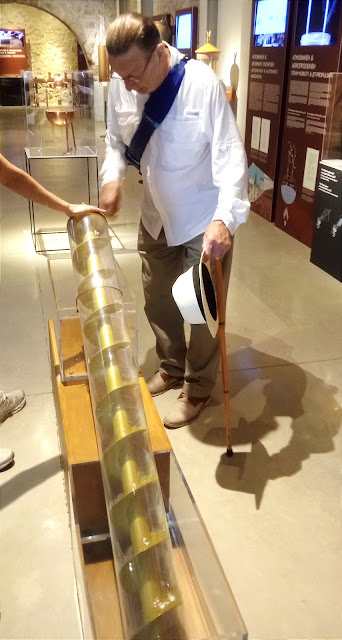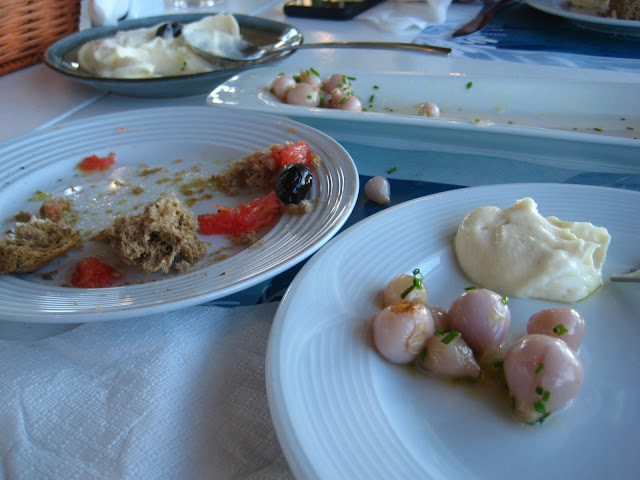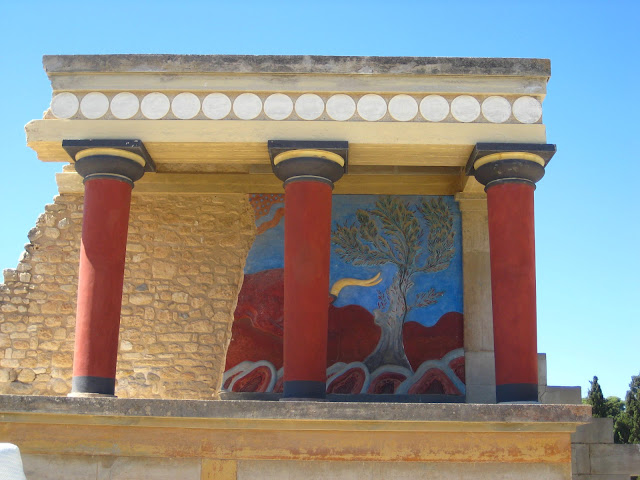September 15-17
Friday began with a visit to the Museum of Ancient Greek Technology. Many of the exhibits were novelties, like the steam powered rotating ball.
It was the first use of steam power, yes, but it would be 2000 years or more before anyone actually put it to practical work. There was also a jug using a system of valves so you could pour water and wine from the same vessel.
There were automated puppet shows using elaborate transmissions and cutout figures.
There were also models of hoisting devices with complex gear mechanisms that raised the stones for the grand buildings of the city.
I was hoping to see an Archimedean screw, a water-raising device attributed to Archimedes, who was involved in the development of many of the objects on display.
I not only got to see a fair-size model of one, but even got to crank it. Larry caught the picture of the day.
At dinnertime, Larry, who I may have mentioned was our minister of gastronomy, led us to Archipelagos, a well-reviewed seafood restaurant not far from the Venetian port.
We shared several exotic dishes: Fish roe dip, hibiscus bulbs, fried anchovies, grilled baby squid, grilled sardines. The bulbs looked like pearl onions. All the dishes were superb, like most of the food we have had in Greece.
Larry paired the food with another fantastic local white wine.
Dessert, we discovered early on in our Cretan dining, is frequently on the house. It usually consists of a 100 milliliter bottle of anise-flavored liqueur, usually raki or ouzo, accompanied by a few sweets.
Archipelagos served us ouzo, along with two plates of gelato and chocolate cake, which Larry and I took, while Joanna had gelato with baklava. It’s almost as if they knew she doesn’t really care for chocolate.
Later, Larry and I sat on the balcony outside his room to take more wine and some raki, which is similar to grappa and isn’t as sweet as ouzo.
Saturday Joanna and I walked to waterfront again. We took a different route. I think the street is named Evans, after the archaeologist of Knossos.
It ended at a plaza that Joanna recognized. We had been here a few nights earlier with Larry looking for a restaurant. When she pointed out the “Intercontinental” sign I recognized it too.
We took the familiar pedestrian street back to the hotel. On the way, we decided to stop at a church that received considerable attention each time we had passed it before.
The church, we discovered, is the cathedral of the archbishopric of Crete and is dedicated to St. Titus, who appears in the New Testament book called Acts of the Apostles.
Titus had accompanied St. Paul in his missions, including the one to Crete. Paul left the island after a short stay and had Titus stay to preach Christian sermons and make conversions.
According to Wikipedia, there had been a series of churches on the site. The current building was built in the 19th century as a mosque and was later taken over as a Christian church.
Like most orthodox churches I have seen, it is colorful and enhanced with images in the Byzantine style.
We walked around deciphering some of the names on icons. There were two large paintings of groups on the rear wall of the nave. One may represent the Dormition of the Virgin, in other words the death of Mary, the mother of Jesus. If that’s so, the other painting would be the Assumption.
The Orthodox and Roman Catholic Churches both accept the doctrine that the Virgin Mary was assumed bodily into heaven. A Greek Orthodox friend once told me that the churches disagree on one point. The Orthodox believe she died before the Assumption. The Catholics believe she did not die.
We stepped into a side chapel to see the principal relic of the church, the skull of St. Titus. It is held in an embellished reliquary, which is open at the top. I felt that it would be taken as blasphemous if I tried to peek into the opening to see the actual skull, so I reined in my curiosity.
We stopped to buy a charm for Joanna’s Pandora bracelet. She chose a miniature of an artifact from Minoan times. The original, which is in one of the many archaeological museums, is the figure of a bee, an important creature to the Minoans, who exported honey as far as Egypt.
We joined Larry for our last dinner in Heraklion, which was at Avli. When we had eaten there before, we had liked it so much that we immediately reserved a table for our last dinner together. Last, because Joanna and I were heading to Athens and then home, while Larry was on his way to the beach at Rhodes.
There’s more to the story, though.
Larry had gone to a wine store near Avli and had run into Marilena, our waitress from the other night. He discovered that she owns the wine store. An enterprising family, indeed. She had stopped at the store to pick up a few bottles for the restaurant.
The family had laid in the goat for our dinner. When it came to the table, it had been braised to a succulent tenderness in tomato sauce with a variety of seasonings. They also served us snails made in a new way, almost a risotto.
The local red wine, recommended by Marilena, was nearly as good as the food.
Before we left, Joanna got a recap of the recipe from Katerina, the chef.
We had an 11 a.m. checkout time at the apartment on Sunday. We had no place to store our bags, so we had to go to the airport way too early for a flight at 6:45. Sky Express wouldn’t check our big bag until two hours before flight time.
We put most of our luggage in a baggage storage office and cabbed back to the Venetian port.
I took my bag with my computer because we expected to spend a few hours dawdling at cafes in the area. I’m not sure that was entirely realistic thinking.
The first bistro was a bust. We ordered something called crab salad and expected to get lumps of crab meat with leafy greens.
Not so. It was like eating in Indiana. There may have been crab in there, but mostly it was strings of cabbage and some thin noodles swimming in mayonnaise.
Joanna couldn’t stomach any of it. I went through a few forkfuls before we decamped.
We went a few dozen yards to an outdoor cafe called Avra. There we had more luck. It was clearly a tourist joint. Maybe some of the customers were local, but most were from far out of town, like us.
We shared a plate of spaghetti in a seafood sauce: mussels, shrimp, chunks of white meat fish, and I don’t know what all. Delicious.
We tried taking a walk, but my bag was packed for travel and way too heavy for a stroll.
We took a cab back to the airport. We found place to sit and and there was a lot of time to compare notes with Joanna and begin writing. The wifi was useless, so fact-checking would have to wait.
The flight to the Athens airport in Piraeus takes about an hour. The cab ride to central Athens lasts almost as long.
Our hotel, the Noma, is on a small street lined with restaurants. It was an OK place. It was clean, but way too cramped. We kept tripping over furniture. The bathroom was so small there was no place to keep toilet paper.
It was on a shelf in the hall when we arrived. While we were there we stored the roll on the closed toilet seat cover.
The location is so great, though, that if it was the only game in town, I’d stay at the Noma again.
We found a place for dinner right outside the door. Named for booze and snacks, Raki Meze did not disappoint.
We had a beetroot salad with orange slices and walnuts. When it arrived, with all the ingredients carefully arranged, it looked like something Salvador Dali
would serve to Gala.
Then we dug into the grilled sardines with oregano and another dish of grilled chicken with a fruit sauce made of oranges and mustard.
It was all very good, even the chicken with the strange dressing. We knew it would be. Anything that sounds so wrong has to be great.
After a bit of raki for dessert, it was time to crash.
That’s all for now, gang.
I’m still working on the rest.
Be well, everyone, and remember: When the going gets raki, sip it. It’s the good stuff.
Love to all.
Joanna and Harry




















